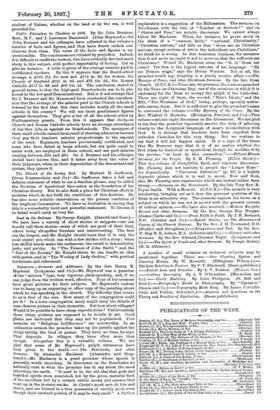Public Education in Cheshire in 1896. By Sir John Brunner,
Bart., M.P., and J. Lawrence Hammond. (John Heywood.)—Sir John Brunner and his colleague have collected in this volume a number of facts and figures, and they have drawn certain con- clusions from them. The value of the facts and figures is un- questionable. The conclusions are vitiated by prejudice. Indeed, it is difficult to credit the writers, who have evidently devoted much study to this subject, with perfect impartiality of feeling. Let us give an instance. A table is given of the average salaries paid to certificated teachers. By this it appears that the Board-school average is £162 11s, for men and £114 4e. 3d. for women, the Church of England .£121 4s. 3d. and £75 10s. 5d., the Roman Catholic .2117 3s. 3d. and £66 14s. 4d. The conclusion, stated in general terms, is that the high-paid Board-schools are to be pre- ferred to the low-paid Denominational. But is it not strange that Sir J. Brunner and Mr. Hammond have overlooked the considera- tion that the average of the salaries paid in the Church schools is lowered by the fact that this class includes nearly all the small schools in the county ? We will use these gentlemen's figures against themselves. They give a list of all the schools aided by Parliamentary grants. From this it appears that thirty-six Church and Roman Catholic schools have an average attendance of less than fifty as against six Board-schools. The managers of these small schools cannot be accused of starving education because they pay their teachers salaries proportionate to the amount of the work. Beginners, teachers provisionally certificated, and some who have failed in large schools, but are quite equal to easier work, are employed in these schools, and are paid salaries varying between .250 and .e,60. Sir J. Brunner and his colleague should have known this, and it takes away from the value of their judgment, when, in their depreciation of the denominational system, they ignore it.


































 Previous page
Previous page